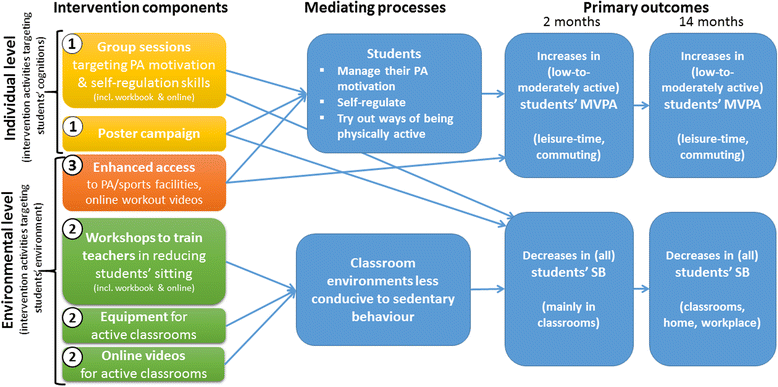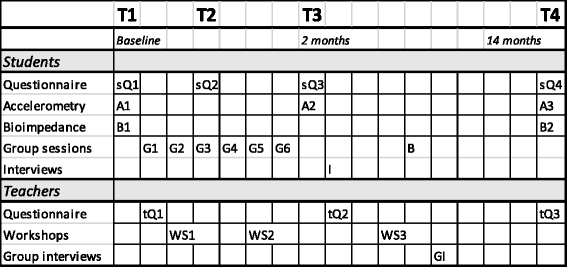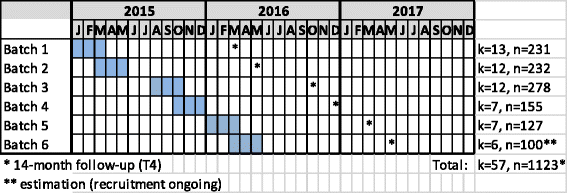'Let's Move It' - a school-based multilevel intervention to increase physical activity and reduce sedentary behaviour among older adolescents in vocational secondary schools: a study protocol for a cluster-randomised trial
- PMID: 27229682
- PMCID: PMC4882860
- DOI: 10.1186/s12889-016-3094-x
'Let's Move It' - a school-based multilevel intervention to increase physical activity and reduce sedentary behaviour among older adolescents in vocational secondary schools: a study protocol for a cluster-randomised trial
Abstract
Background: Physical activity (PA) has been shown to decline during adolescence, and those with lower education have lower levels of activity already at this age, calling for targeted efforts for them. No previous study has demonstrated lasting effects of school-based PA interventions among older adolescents. Furthermore, these interventions have rarely targeted sedentary behaviour (SB) despite its relevance to health. The Let's Move It trial aims to evaluate the effectiveness and the cost-effectiveness of a school-based, multi-level intervention, on PA and SB, among vocational school students. We hypothesise that the intervention is effective in increasing moderate-to-vigorous-intensity physical activity (MVPA), particularly among those with low or moderate baseline levels, and decreasing SB among all students.
Methods: The design is a cluster-randomised parallel group trial with an internal pilot study. The trial is conducted in six vocational schools in the Helsinki Metropolitan area, Finland. The intervention is carried out in 30 intervention classes, and 27 control classes retain the standard curriculum. The randomisation occurs at school-level to avoid contamination and to aid delivery. Three of the six schools, randomly allocated, receive the 'Let's Move It' intervention which consists of 1) group sessions and poster campaign targeting students' autonomous PA motivation and self-regulation skills, 2) sitting reduction in classrooms via alterations in choice architecture and teacher behaviour, and 3) enhancement of PA opportunities in school, home and community environments. At baseline, student participants are blind to group allocation. The trial is carried out in six batches in 2015-2017, with main measurements at pre-intervention baseline, and 2-month and 14-month follow-ups. Primary outcomes are for PA, MVPA measured by accelerometry and self-report, and for SB, sedentary time and breaks in sedentary time (accelerometry). Key secondary outcomes include measured body composition, self-reported well-being, and psychological variables. Process variables include measures of psychosocial determinants of PA (e.g. autonomous motivation) and use of behaviour change techniques. Process evaluation also includes qualitative interviews. Intervention fidelity is monitored.
Discussion: The study will establish whether the Let's Move It intervention is effective in increasing PA and reducing SB in vocational school students, and identify key processes explaining the results.
Trial registration: ISRCTN10979479 . Registered: 31.12.2015.
Keywords: Accelerometer; Adolescents; Behaviour change; Complex intervention; Physical activity; School-based intervention; Sedentary behavior; Vocational school.
Figures



References
-
- van Sluijs EMF, McMinn AM, Griffin SJ. Effectiveness of interventions to promote physical activity in children and adolescents: systematic review of controlled trials. BMJ. 2007;335(7622):703. doi: 10.1136/bmj.39320.843947.BE. - DOI - PMC - PubMed
Publication types
MeSH terms
Associated data
Grants and funding
LinkOut - more resources
Full Text Sources
Other Literature Sources
Medical

